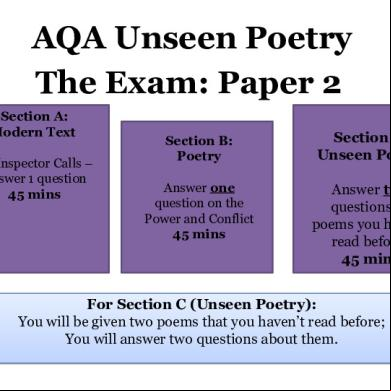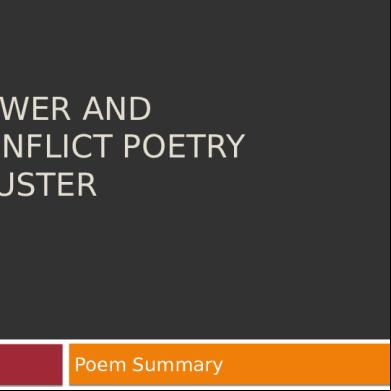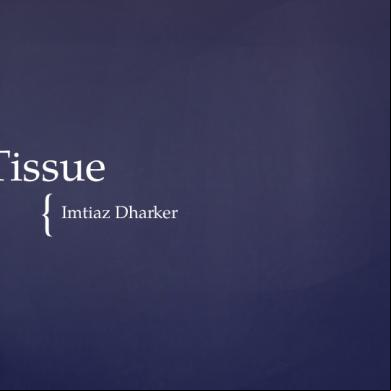Unseen Poetry Revision 294l4o
This document was ed by and they confirmed that they have the permission to share it. If you are author or own the copyright of this book, please report to us by using this report form. Report 445h4w
Overview 1s532p
& View Unseen Poetry Revision as PDF for free.
More details 6h715l
- Words: 1,346
- Pages: 13
AQA Unseen Poetry The Exam: Paper 2 Section A: Modern Text An Inspector Calls – Answer 1 question 45 mins
Section B: Poetry
Section C: Unseen Poetry
Answer one question on the Power and Conflict 45 mins
Answer two questions on poems you haven't read before. 45 mins
For Section C (Unseen Poetry): You will be given two poems that you haven’t read before; You will answer two questions about them.
Unseen Poetry Questions Question 1: • •
Worth 24 marks; Analyse one poem.
Question 2: • •
Worth 8 marks; Compare similarities and differences with the first poem.
You should cover: What the poem is about; The key message, theme and ideas; How the poet uses form and structure to communicate ideas.
You should cover: The techniques used by the poets; Form, structure and language.
30 minutes
15 minutes
Key Tips: Question 1 is worth more marks – spend more time on Q1!
What is the examiner looking for? • That you understand what the poems are about; • The use of techniques and their impact; • Ability to ideas and interpretations with evidence; • Use correct technical .
?
So, I have a poem… what do I do with it?! S
Structure
• What does the poem look like on the page? How is it set out? How many stanzas? How many lines? How many words per line? Is there a pattern to this? What kind of punctuation has been used?
M
Meaning
• What are the poet’s thoughts/feelings about the subject of the poem? How do you know? • There are often two layers to a poem: the obvious meaning and the deeper meaning
I
Images
• How has the poet brought the scene to life? What images are created of the subject of the poem?
L
Language
• Look at the effect of specific verbs/metaphors/similes/oxymorons/personification here • You may also look for ‘sound effect’ language techniques such as alliteration, sibilance, onomatopoeia • to comment on the effect of any technique used – if it’s not there, don’t mention it!
E
Emotions and effect on you
• What emotions in the reader is the poet trying to achieve? Does the poem have this effect on you? Why/ why not?
MEANING Really is the most important part of SMILE as every other point needs to link back to how it effects/con tributes to meaning
LANGUAGE
STRUCTURE
Alliteration: When there is a repeated letter at the
Line length: How long are the lines? Does the
beginning of each word.
length of certain lines have any significance?
Onomatopoeia: when words mimic the sound of the Punctuation: Often significant, punctuation helps object they are describing. E.G. Pop, Zip.
to illuminate the meaning of a poem. Look closely at how much punctuation is used, why is it there?
Personification: occurs when inanimate objects are Narrative Voice: Personal pronouns help tell you given human characteristics. E.g. The wind howled.
who is speaking in a poem. E.g. I, they, she, he. ** Be aware even if it is ‘I’ it may not be the poet speaking directly, but using an imagined persona in order to convey a certain perspective. **
Assonance: The repetition of vowel sounds in words
Repetition: Repetition of words or phrases creates
that are close to each other. E.g. “The looming moon”.
emphasis of a meaning. Always think about what the poet is trying to convey.
Questions or Commands: If there are questions
Layout: often contributes to meaning. Any unusual
or commands in a poem you are studying, think about why the writer has chosen this type of language.
layout will usually have a deeper meaning or sub-text adding to the themes or ideas within the poem.
Sibilance:
A repeated ‘s’ sound E.g. ‘the smooth snake slithered slowly’
Timescale: When the poem takes place- sometimes
Imagery: Poets create vivid images in their readers’ minds through: Metaphors- A way of comparing things by saying
Rhyme/Rhythm: Revolves around how many syllables
one thing ‘IS’ something else.
Similes- A way or comparing things using ‘LIKE’ or ‘AS’.
it will be written like a chronological story, other poems will describe one single moment. each line has. Read a poem out loud to hear the rhythm. Rhyme also contributes to rhythm. **The rhythm of a poem can directly influence a poem’s tone or mood**
Steps to Success 1. Read the question before you read the poem – it will give you a clue for what to look for.
Ninetieth Birthday by R. S. Thomas You go up the long track That will take a car, but is best walked On slow foot, noting the lichen That writes history on the page Of the grey rock. Trees are about you At first, but yield to the green bracken, The nightjars house: you can hear it spin On warm evenings; it is still now In the noonday heat, only the lesser Voices sound, blue-fly and gnat And the stream's whisper. As the road climbs, You will pause for breath and the far sea's Signal will flash, till you turn again To the steep track, buttressed with cloud. And there at the top that old woman, Born almost a century back In that stone farm, awaits your coming; Waits for the news of the lost village She thinks she knows, a place that exists In her memory only. You bring her greeting And praise for having lasted so long With time's knife shaving the bone. Yet no bridge s her own World with yours, all you can do Is lean kindly across the abyss To hear words that were once wise.
2. Read the poem through once and highlight words and phrases that stand out and that you think are interesting. Let’s do this now.
3. Read the poem through a second time and this time LABEL language techniques and features that will help you answer the question. Try to find at least 2 good examples. Let’s do this now.
4. Read the poem through a third time looking for structural techniques and annotate the effect of the techniques around the poem. Let’s do this now.
5. Answer the question using PEE. • Firstly, discuss how the poet uses language to talk about old age and people’s attitudes towards it. Why did the poet use it? How does it create meaning? What effect do these techniques have on the reader? • Secondly, discuss how the poet uses structure to talk about old age and people’s attitudes towards it. Why did the poet use it? How does it create meaning? What effect do these techniques have on the reader? • Thirdly, talk about your own thoughts and feelings on the poem.
Comparison question
My Grandmother by Elizabeth Jennings She kept an antique shop – or it kept her. Among Apostle spoons and Bristol glass, The faded silks, the heavy furniture, She watched her own reflection in the brass Salvers and silver bowls, as if to prove Polish was all, there was no need of love. And I how I once refused To go out with her, since I was afraid. It was perhaps a wish not to be used Like antique objects. Though she never said That she was hurt, I still could feel the guilt Of that refusal, guessing how she felt. Later, too frail to keep a shop, she put All her best things in one narrow room. The place smelt old, of things too long kept shut, The smell of absences where shadows come That can’t be polished. There was nothing then To give her own reflection back again. And when she died I felt no grief at all, Only the guilt of what I once refused. I walked into her room among the tall Sideboards and cupboards – things she never used But needed; and no finger marks were there, Only the new dust falling through the air.
Compare how the poet’s use: • Language • Structure In each paragraph make sure to answer the question and talk about the effect on the reader.
Section B: Poetry
Section C: Unseen Poetry
Answer one question on the Power and Conflict 45 mins
Answer two questions on poems you haven't read before. 45 mins
For Section C (Unseen Poetry): You will be given two poems that you haven’t read before; You will answer two questions about them.
Unseen Poetry Questions Question 1: • •
Worth 24 marks; Analyse one poem.
Question 2: • •
Worth 8 marks; Compare similarities and differences with the first poem.
You should cover: What the poem is about; The key message, theme and ideas; How the poet uses form and structure to communicate ideas.
You should cover: The techniques used by the poets; Form, structure and language.
30 minutes
15 minutes
Key Tips: Question 1 is worth more marks – spend more time on Q1!
What is the examiner looking for? • That you understand what the poems are about; • The use of techniques and their impact; • Ability to ideas and interpretations with evidence; • Use correct technical .
?
So, I have a poem… what do I do with it?! S
Structure
• What does the poem look like on the page? How is it set out? How many stanzas? How many lines? How many words per line? Is there a pattern to this? What kind of punctuation has been used?
M
Meaning
• What are the poet’s thoughts/feelings about the subject of the poem? How do you know? • There are often two layers to a poem: the obvious meaning and the deeper meaning
I
Images
• How has the poet brought the scene to life? What images are created of the subject of the poem?
L
Language
• Look at the effect of specific verbs/metaphors/similes/oxymorons/personification here • You may also look for ‘sound effect’ language techniques such as alliteration, sibilance, onomatopoeia • to comment on the effect of any technique used – if it’s not there, don’t mention it!
E
Emotions and effect on you
• What emotions in the reader is the poet trying to achieve? Does the poem have this effect on you? Why/ why not?
MEANING Really is the most important part of SMILE as every other point needs to link back to how it effects/con tributes to meaning
LANGUAGE
STRUCTURE
Alliteration: When there is a repeated letter at the
Line length: How long are the lines? Does the
beginning of each word.
length of certain lines have any significance?
Onomatopoeia: when words mimic the sound of the Punctuation: Often significant, punctuation helps object they are describing. E.G. Pop, Zip.
to illuminate the meaning of a poem. Look closely at how much punctuation is used, why is it there?
Personification: occurs when inanimate objects are Narrative Voice: Personal pronouns help tell you given human characteristics. E.g. The wind howled.
who is speaking in a poem. E.g. I, they, she, he. ** Be aware even if it is ‘I’ it may not be the poet speaking directly, but using an imagined persona in order to convey a certain perspective. **
Assonance: The repetition of vowel sounds in words
Repetition: Repetition of words or phrases creates
that are close to each other. E.g. “The looming moon”.
emphasis of a meaning. Always think about what the poet is trying to convey.
Questions or Commands: If there are questions
Layout: often contributes to meaning. Any unusual
or commands in a poem you are studying, think about why the writer has chosen this type of language.
layout will usually have a deeper meaning or sub-text adding to the themes or ideas within the poem.
Sibilance:
A repeated ‘s’ sound E.g. ‘the smooth snake slithered slowly’
Timescale: When the poem takes place- sometimes
Imagery: Poets create vivid images in their readers’ minds through: Metaphors- A way of comparing things by saying
Rhyme/Rhythm: Revolves around how many syllables
one thing ‘IS’ something else.
Similes- A way or comparing things using ‘LIKE’ or ‘AS’.
it will be written like a chronological story, other poems will describe one single moment. each line has. Read a poem out loud to hear the rhythm. Rhyme also contributes to rhythm. **The rhythm of a poem can directly influence a poem’s tone or mood**
Steps to Success 1. Read the question before you read the poem – it will give you a clue for what to look for.
Ninetieth Birthday by R. S. Thomas You go up the long track That will take a car, but is best walked On slow foot, noting the lichen That writes history on the page Of the grey rock. Trees are about you At first, but yield to the green bracken, The nightjars house: you can hear it spin On warm evenings; it is still now In the noonday heat, only the lesser Voices sound, blue-fly and gnat And the stream's whisper. As the road climbs, You will pause for breath and the far sea's Signal will flash, till you turn again To the steep track, buttressed with cloud. And there at the top that old woman, Born almost a century back In that stone farm, awaits your coming; Waits for the news of the lost village She thinks she knows, a place that exists In her memory only. You bring her greeting And praise for having lasted so long With time's knife shaving the bone. Yet no bridge s her own World with yours, all you can do Is lean kindly across the abyss To hear words that were once wise.
2. Read the poem through once and highlight words and phrases that stand out and that you think are interesting. Let’s do this now.
3. Read the poem through a second time and this time LABEL language techniques and features that will help you answer the question. Try to find at least 2 good examples. Let’s do this now.
4. Read the poem through a third time looking for structural techniques and annotate the effect of the techniques around the poem. Let’s do this now.
5. Answer the question using PEE. • Firstly, discuss how the poet uses language to talk about old age and people’s attitudes towards it. Why did the poet use it? How does it create meaning? What effect do these techniques have on the reader? • Secondly, discuss how the poet uses structure to talk about old age and people’s attitudes towards it. Why did the poet use it? How does it create meaning? What effect do these techniques have on the reader? • Thirdly, talk about your own thoughts and feelings on the poem.
Comparison question
My Grandmother by Elizabeth Jennings She kept an antique shop – or it kept her. Among Apostle spoons and Bristol glass, The faded silks, the heavy furniture, She watched her own reflection in the brass Salvers and silver bowls, as if to prove Polish was all, there was no need of love. And I how I once refused To go out with her, since I was afraid. It was perhaps a wish not to be used Like antique objects. Though she never said That she was hurt, I still could feel the guilt Of that refusal, guessing how she felt. Later, too frail to keep a shop, she put All her best things in one narrow room. The place smelt old, of things too long kept shut, The smell of absences where shadows come That can’t be polished. There was nothing then To give her own reflection back again. And when she died I felt no grief at all, Only the guilt of what I once refused. I walked into her room among the tall Sideboards and cupboards – things she never used But needed; and no finger marks were there, Only the new dust falling through the air.
Compare how the poet’s use: • Language • Structure In each paragraph make sure to answer the question and talk about the effect on the reader.









